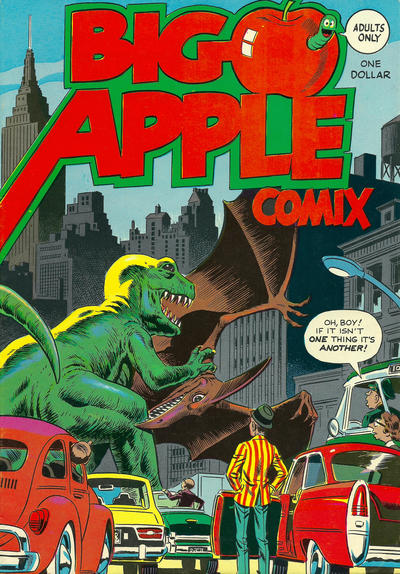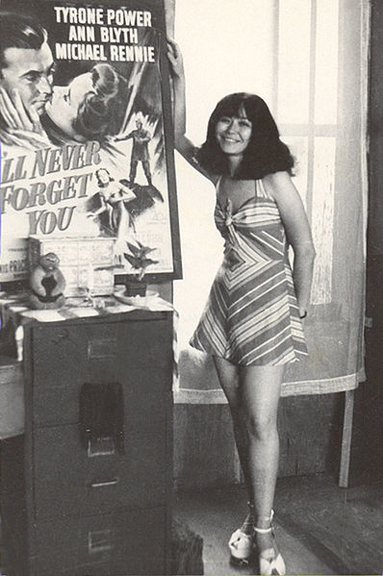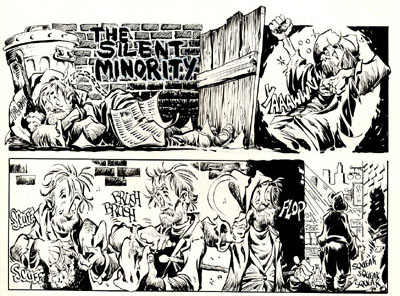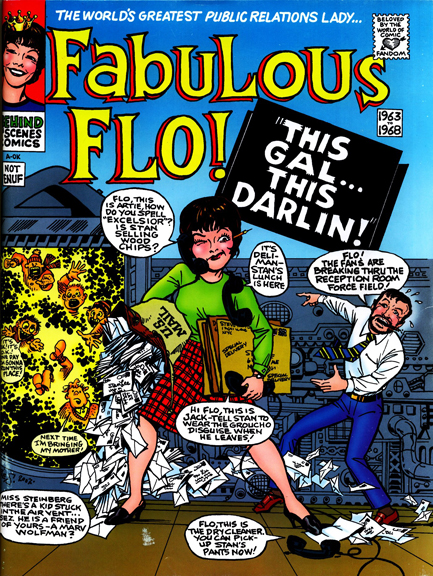COMIC BOOKS THAT TIME FORGOT: BIG APPLE COMIX
by KC Carlson
Florence Steinberg (aka “Fabulous Flo”) saw the birth of the Marvel Age of comics from an interesting perspective — she was one of the first two employees of Marvel Comics. (The other was some guy named Stan Lee. Sounds fake to me…) Hired as Stan’s “Gal Friday” (an old-timey reference to what would today be an Executive Assistant) in 1963, Flo wrangled fan letters, assisted with the Marvel letter columns, answered phones, did general office work (which probably included mailing out “No Prizes”), and kept track of where all the freelancers were on their assignments.
As we know now, the early Marvel Bullpen of writers and artists working together in the offices was mostly fiction, although as Marvel became more successful (and could afford better offices), common areas for visiting freelancers became available. Otherwise, they all worked at home. Flo was instrumental in keeping that secret, as well as getting to know all of the Marvel freelancers quite well, as she was the one everybody had to talk to before they could get in to see Stan.
SIMPLY FABULOUS
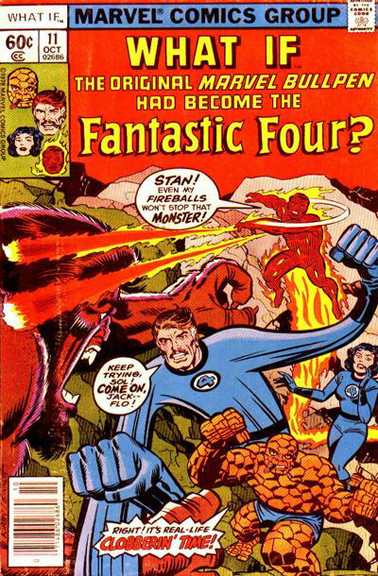
What If #11. Flo appears on the cover and the interiors of this infamous issue, where the Marvel Bullpen becomes the Fantastic Four!
Since Stan kept mentioning her in the lettercols and Bullpen Bulletins, Flo became one of the most beloved comic book people in the 1960s, and she charmed freelancers and fans alike. Thus, it was shocking when she left the Bullpen in 1968, exhausted from sending out Merry Marvel Marching Society fan club packets and dealing with the overwhelming amount of fan mail. She asked for a $5 raise. The bosses said no. So Flo left. Artist/colorist Marie Severin (another great comic book dame) had this to say about that:
“I think the stupidest thing Marvel ever did was not give her a raise when she asked for it because she would have been such an asset to have around later because she’s so honest and decisive. … I was thinking, ‘What the hell is the problem with these people? She’s a personality. She knows what she’s doing. She handles the fans right. She’s loyal to the company. Why the hell won’t they give her a decent raise? Dummies.'” (From Comic Book Artist #18, 2002)
Flo was involved with a number of projects/jobs for the next several years, including assisting with Captain Company, Warren Publishing’s mail-order division, and attending comic book conventions. She spoke about the role of women in comics alongside Marie Severin, Jean Thomas (sometime collaborator with then-husband Roy), and then-fan (and future comics professional) Irene Vartanoff at the 1974 New York Comic Art Convention.
TRAILBLAZING PUBLISHER
And then Flo decided to become a comic publisher. Knowing all those freelance artists and writers would come in handy.
Big Apple Comix arrived in 1975 (September, according to the indicia) as 32 ad-less black and white pages, with color covers, priced at one dollar. It’s labeled “Adults Only” on the cover, for good reason once you get inside. The short stories by a variety of New York-based comic talent aim to capture the adult side of life in the big city, including profanity and nudity. Big Apple Comix is one of a handful of releases considered early links between underground comix and modern independent/alternative comics. (Others include Mike Friedrich’s Star*Reach, Wally Wood’s witzend, and Mark Evanier’s High Adventure.)
WOODY’S “WORD”
Wood would be a major contributor to Big Apple Comix, participating in the artist jam cover with Stu Schwartzberg, Larry Hama, and Paul Kirchner (but it looks like mostly Wood to me). Wood also wrote “The Tube”, which was illustrated by Al Williamson, and inked Herb Trimpe on “Lotsa Yox”, a newspaper strip parody about a pilot who shoots giant monkeys with his biplane. Wood also wrote and drew one of the comic’s centerpieces, “My Word”, a blistering parody of the Al Feldstein-scripted “My World”, which Wood illustrated in EC Comics’ Weird Science #22 (Dec. 1953). The newer story included an unforgettable two-panel swipe at both publishers and comic fans — which is actually one of the tamest things in the piece.
In the old days, Flo would chase Wally around the Marvel office, trying to grab the ever-present cigarette out of his hand because he got ashes all over the office carpeting. She was always successful, but he was always lighting up another one by the time he sat down in Stan’s office. It was a little game that they would play.
In an essay by Steinberg written for Bhob Stewart’s Against the Grain: Mad Artist Wallace Wood (TwoMorrows, 2003), Flo talks about how supportive Wood was on the Big Apple project, especially with advice on how she could overcome her lack of artistic ability to complete the inside back cover shot of the Statue of Liberty holding a Big Apple. “Wood suggested using a swipe-o-graph, a time-honored artistic tradition. My problem was solved in minutes. As he told his assistants: ‘Never draw anything you can copy; never copy anything you can trace; never trace anything you can cut out and paste in.’”
MORE GREAT STUFF
Williamson’s hero character in “The Tube” doesn’t look that heroic. In fact, he looks like the typical young comics professional in 1975: long, kinda stringy hair; glasses; not-so athletic build. His name is Brad Brickford. The naked women who inspire him to become the planet’s champion and kill the beast who has kidnapped the also naked queen are all much taller than Brad. Needless to say the ending is not what you think, although the bib is a nice touch. Williamson (wearing a jacket with an E.C. patch on the sleeve) cameos in the last panel, explaining that it took him 17 months to draw this three-page story and thanking both Wood and Dan Green.
“Over and Under” is an interesting experiment, telling two different (but related) stories simultaneously about high-class advertising execs and low-class whores. Neal Adams wrote and drew the left side of each page, and Larry Hama wrote and drew the right side, with inking by Ralph Reese. It’s not much of a story (you get the point by page two), but it is very pretty and features very detailed artwork by all the artists involved.
Archie Goodwin cartooned a two-page story about peep shows in an art style that is not quite up to his subsequent Epic Comics editorial cartooning. But the story is pure Archie, comparing and contrasting “sleezy” peep shows to “klassy” ones, in sort of a twisted National Geographic travelog kind of way. Part of the humor here is that you can’t imagine Archie doing any of this stuff. Or can you…? The Archie Goodwin I knew wanted to clobber professional wrestlers with his umbrella, like those old grannies you’d see on 50s wrestling TV shows.
Mike Ploog contributed a two-page dialogue-free story called “The Silent Minority”, about the plight of the homeless. The art is very interesting, as it’s much looser than his contemporary work for Marvel was.
And Herb Trimpe contributed a four-page silent story called “Token”, a “message” story that wraps up the issue very nicely. His interesting layouts and design show off talents that he was never called upon to use in his work at Marvel.
Other contributors included Denny O’Neil (Forward); Stu Schwartzberg and Marie Severin (“The Man Without a City”, about a man who complains too much about NYC and is exiled from it for the rest of his life); Alan and Howard Weiss (“The Battery’s Down”, an unpleasant story which is marred by both hard-to-read dialogue and unattractive lettering); and a typically odd one-page feature about “New York City: The Future” by Paul Kirchner (The Bus). Marvel staffers Linda Fite and John Verpoorten provided production, and Fite also cartooned a one-pager.
THE UPSIDE: NO DOWNSIDE!
Flo’s main idea for the comic jelled after returning to NYC after living in San Francisco for a bit. She noted that most of the underground comics originated in San Francisco, and her thinking was that NYC should have its own comic book. She produced Big Apple Comix during the time she was working at Warren managing the Captain Company, and Jim Warren was very supportive of the project, allowing Steinberg to store her comics there and also offering advice.
In an interview with Jon B. Cooke in Comic Book Artist #4, Flo revealed the the ultimate — and positive! — fate of Big Apple Comix: “I made the money back and a little more… They (the contributors) got about $10 a page! [laughs]… I was hoping it would sell well, and it did get some nice write-ups. It’s sort of politically incorrect when you look at it now, and while I was embarrassed about it for a few years, now I think it’s a riot! [laughs] I’m really fond of that book.”
So, a profitable comic book, and groundbreaking in that it is now an important part of comic book history. Way to go, Flo!
_____________________________
KC CARLSON: I met Flo very briefly when I was working for DC Comics in the 90s, when she visited the offices once. Within thirty seconds of chatting with her, I realized that every gushing thing Stan said about Flo in the sixties was not hype but absolutely true.
For more information about “Fabulous Flo” Steinberg, seek out back issues of Comic Book Artist #4 and #18, where she is interviewed about both Warren and Marvel. Digital copies are available at the TwoMorrows website. And based on the amount of information you get in each issue, the cost is amazing — plus, as of this writing, they’re also on sale!

